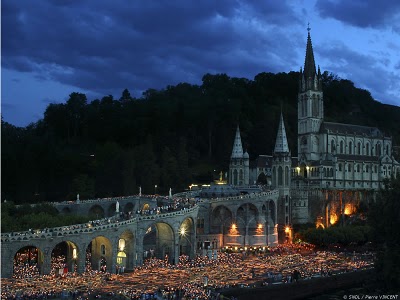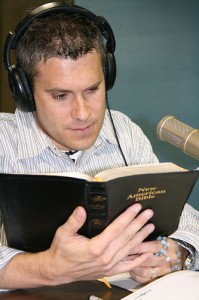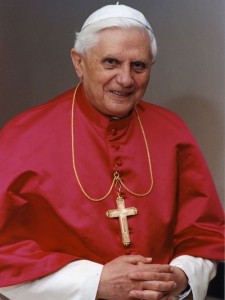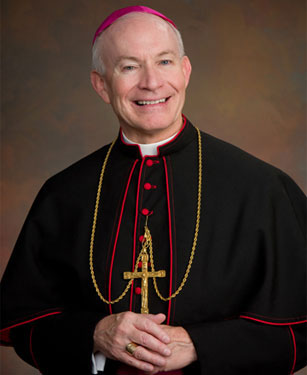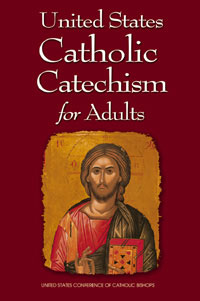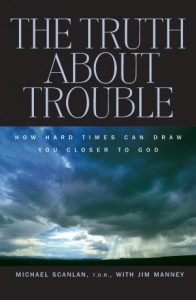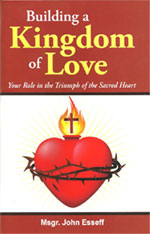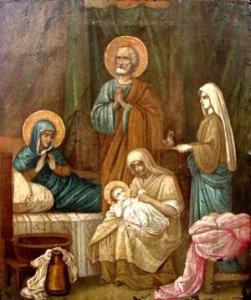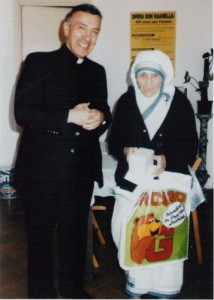“So must the Son of Man be lifted up”
[powerpress]
an excerpt from today’s reflection by Don Schwager:
Do you know the healing power of the cross of Christ? Jesus explained to Nicodemus the necessity of his impending crucifixion and resurrection by analogy with Moses and the bronze serpent in the desert.When the people of Israel were afflicted with serpents in the wilderness because of their rebellion and sin, God instructed Moses: “Make a fiery serpent, and set it on a pole; and every one who is bitten, when he sees it, shall live” (Numbers 21:8). The bronze serpent points to the cross of Christ which defeats sin and death and obtains everlasting life for those who believe in Jesus and in his victory on the cross. The result of Jesus “being lifted up on the cross” and his rising and exaltation to the Father’s right hand in heaven, is our “new birth in the Spirit” and adoption as sons and daughters of God. God not only redeems us, but he fills us with his own divine life and power that we might share in his glory.
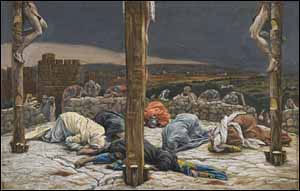 There is no greater proof of God’s love for his fallen creatures. “To ransom a slave God gave his Son” (an ancient prayer from the Easter vigil liturgy). God sent his Son to free us from the worst of tyrannies – slavery to sin and the curse of death. Jesus’ sacrificial death was an act of total love in self-giving. Jesus gave himself completely out of love for his Father. And he willing layed down his life out of selfless love for our sake and for our salvation. His death on the cross was both a total offering to God and the perfect sacrifice of atonement for our sin and the sin of the world.
There is no greater proof of God’s love for his fallen creatures. “To ransom a slave God gave his Son” (an ancient prayer from the Easter vigil liturgy). God sent his Son to free us from the worst of tyrannies – slavery to sin and the curse of death. Jesus’ sacrificial death was an act of total love in self-giving. Jesus gave himself completely out of love for his Father. And he willing layed down his life out of selfless love for our sake and for our salvation. His death on the cross was both a total offering to God and the perfect sacrifice of atonement for our sin and the sin of the world.
John tells us that God’s love has no bounds or limits (John 3:16). His love is not limited to one people or a few chosen friends. His love is limitless because it embraces the whole world and every individual created in “his image and likeness”. God is a persistent loving Father who cannot rest until all of his wandering children have returned home to him. Saint Augustine says, God loves each one of us as if there were only one of us to love. God gives us the freedom to choose whom and what we will love and not love. Jesus shows us the paradox of love and forgiveness and judgment and condemnation. We can love the darkness of sin and unbelief or we can love the light of God’s truth, goodness, and mercy. If our love is guided by truth, goodness, and that which is truly beautiful, then we will choose for God and love him above all else. What we love shows what we prefer. Do you love God who is the supreme good above all else? And do you seek to put him first in all your thoughts, cares, choices, and actions?
“Lord Jesus Christ, your death brought life for us. Fill me with your Holy Spirit that I may walk in freedom and joy as a child of God and as an heir with Christ of an eternal inheritance.”
for the full reflection visit : Daily Reading and Meditation
Tags: don schwager, gospel of john
This entry was posted on Friday, September 14th, 2012 at 12:05 am
You can follow any responses to this entry through the RSS 2.0 feed.
[powerpress = “Vatican_Radio”]
VATICAN CITY, SEPT. 12, 2012 (Zenit.org).- Here is a translation of the address Benedict XVI gave today in Paul VI Hall at the general audience. The Holy Father today continued his reflection on prayer in the book of Revelation.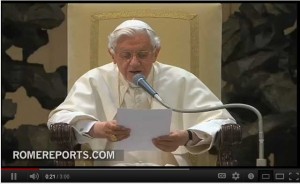
* * *
Dear brothers and sisters,
Last Wednesday I spoke about prayer in the first part of Revelation. Today we move on to the second part of the book; and whereas in the first part, prayer is oriented toward the Church’s inner life, in the second, attention is given to the entire world; the Church, in fact, journeys through history; she is part of it, in accordance with God’s plan.
The assembly that listened to John’s message presented by the reader rediscovered its duty to cooperate in the expansion of the Kingdom of God, as “priests of God and of Christ” (Revelation 20:6; cf. 1:5; 5:10) and it opens out to the world of men. And here, in the dialectical relationship that exists between them, two ways of living emerge: the first we may define as the “system of Christ,” to which the assembly is happy to belong; and the second, the “worldly systems opposed to the kingdom and the covenant and activated through the influence of the Evil One,” who by deceiving men wills to establish a world opposed to the one willed by Christ and by God (cf. Pontifical Biblical Commission, The Bible and Morality, Biblical Roots of Christian Conduct, 70).
The assembly must therefore know how to interpret in depth the history it is living, by learning to discern events with faith in order to cooperate by its action in the growth of the Kingdom of God. And this work of interpretation and discernment, as well as action, is linked to prayer.
First, after the insistent appeal of Christ, who in the first part of Revelation said seven times: “He who has an ear, let him hear what the Spirit says to the Church” (cf. Revelation 2:7,11,17,29; 3:6,13,22), the assembly is invited to ascend to Heaven, to look upon reality through God’s eyes; and here we discover three symbols, reference points from which we may begin to interpret history: the throne of God, the Lamb and the book (cf. Revelation4:1 – 5:14).
The first symbol is the throne, upon which there is seated a person John does not describe, for he surpasses every human representation. He is only able to note the sense of beauty and joy he experiences in His presence. This mysterious figure is God, God Almighty who did not remain enclosed within His heaven but who drew close to man, entering into a covenant with him; God who makes his voice — symbolized by thunder and lightning — heard in history, in a mysterious but real way. There are various elements that appear around the throne of God, such as the twenty-four elders and the four living creatures that unceasingly render praise to the one Lord of history.
The first symbol, then, is the throne. The second symbol is the book, which contains the plan of God for events and for men. It is hermetically sealed with seven seals, and no one is able to read it. Faced with man’s inability to scrutinize the plan of God, John experiences a deep sadness, which causes him to weep. But there is a remedy for man’s dismay before the mystery of history: there is one who is able to open the book and shed light on it.
And here the third symbol appears: Christ, the Lamb immolated in the sacrifice of the Cross, but who stands as a sign of his Resurrection. And it is the Lamb, Christ who died and rose, who gradually opens the seals and unveils the plan of God, the deep meaning of history.
What do these symbols tell us? They remind us of the path to knowing how to interpret the facts of history and of our own lives. By raising our gaze to God’s heaven in a constant relationship with Christ, by opening our hearts and our minds to him in personal and communal prayer, we learn to see things in a new way and to grasp their truest meaning. Prayer is like an open window that allows us to keep our gaze turned toward God, not only for the purpose of reminding us of the goal toward which we are directed, but also to allow the will of God to illumine our earthly journey and to help us to live it with intensity and commitment.
How does the Lord guide the Christian community to a deeper reading of history? First and foremost, by inviting it to consider with realism the present moment we are living. Therefore, the Lamb opens the four first seals of the book, and the Church sees the world in which it is inserted, a world in which various negative elements exist. There the evils that man commits, such as violence, which comes from the desire to possess, to prevail against one another to the point of killing one another (second seal); or injustice, as men fail to respect the laws that are given them (third seal). To these are added the evils that man must undergo, such as death, hunger and sickness (fourth seal). Faced with these oftentimes dramatic realities, the ecclesial community is invited to never lose hope, to believe firmly that the apparent omnipotence of the Evil One collides with the true omnipotence, which is God’s.
And the first seal the Lamb opens contains precisely this message. John narrates: “And I saw, and behold, a white horse, and its rider had a bow; and a crown was given to him, and he went out conquering and to conquer” (Revelation 6:2). The power of God has entered into the history of man, [a power] which is not only capable of offsetting evil, but even of conquering it. The color white recalls the Resurrection: God drew so near to us that he descended into the darkness of death in order to illumine it with the splendor of his divine life: he took the world’s evil upon himself in order to purify it with the fire of his love.
How do we grow in this Christian understanding of reality? Revelation tells us that prayer nourishes this vision of light and profound hope in each one of us and in our communities: it invites us to not allow ourselves to be overcome by evil, but to overcome evil with good, to look to the Crucified and Risen Christ, who associates us in his victory. The Church lives in history, she is not closed in on herself; but rather, she courageously faces her journey amid difficulties and suffering, by forcefully affirming that ultimately, evil does not conquer the good, darkness does not dim the splendor of God.
This is an important point for us; as Christians we can never be pessimists; we know well that along life’s journey we often encounter violence, falsehood, hate and persecution, but this does not discourage us. Above all, prayer teaches us to see the signs of God, of his presence and action; indeed, to be lights of goodness that spread hope and point out that the victory is God’s.
Tags: book of revelation, pope benedict xvi, prayer
This entry was posted on Thursday, September 13th, 2012 at 8:58 am
You can follow any responses to this entry through the RSS 2.0 feed.
Episode 20- Regnum Novum: Bringing forth the New Evangelization through Catholic Social Teaching with Omar Gutierrez – We continue the study of the “Compendium of the Social Doctrine of the Church” Â Chapter 1 Section 2-3
– We continue the study of the “Compendium of the Social Doctrine of the Church” Â Chapter 1 Section 2-3
[powerpress]
CHAPTER ONE
GOD’S PLAN OF LOVE FOR HUMANITY
III. THE HUMAN PERSON IN GOD’S PLAN OF LOVE
a. Trinitarian love, the origin and goal of the human person
b. Christian salvation: for all people and the whole person
c. The disciple of Christ as a new creation
d. The transcendence of salvation and the autonomy of earthly realities
IV. GOD’S PLAN AND THE MISSION OF THE CHURCH
a. The Church, sign and defender of the transcendence of the human person
b. The Church, the Kingdom of God and the renewal of social relations
c. New heavens and a new earth
d. Mary and her “fiat†in God’s plan of love
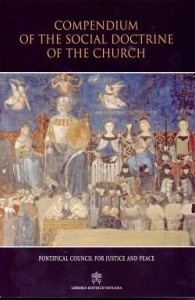
We live at a very special time. The confluence of many things has brought forth the clear need to be able to articulate the Social Teaching of the Catholic Church in a way that is accessible and applicable. This is not to be an effort where high-minded theories are to be bandied about. Rather, this is a time of opportunity wherein we can apply the Social Doctrine to the concrete so as to bring about a New Kingdom, a Revolution. – Omar G.
Also visit Omar’s “Discerning Hearts” page Catholic Social Teaching 101
Tags: catholic social doctine, catholic social teaching, compendium of the social doctrine of the church
This entry was posted on Tuesday, September 11th, 2012 at 6:55 am
You can follow any responses to this entry through the RSS 2.0 feed.
Mark breaks open The TEN COMMANDMENTS–
The First Commandment:
I am the LORD your God, who brought you out of the land of Egypt, out of the house of bondage. You shall have no other gods before me. You shall not make for yourself a graven image, or any likeness of anything that is in heaven above, or that is in the earth beneath, or 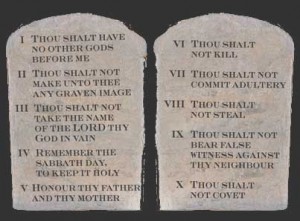 that is in the water under the earth; you shall not bow down to them or serve them.
that is in the water under the earth; you shall not bow down to them or serve them.
[powerpress]
Mark Hart is an author, speaker, director and teacher, Mark’s work both written and spoken, is known across the country and world. While he serves as the Vice President of LIFE TEEN, he is known to tens of thousands simply as the “Bible Geek ®†Mark passionately echoes the gospel to all he encounters. He is as deep as he is funny, and his love for his wife and daughters is second only to his immense love for Jesus Christ.
Visit Mark at www.lifeteen.com
Tags: Bible Geek Mark, jesus christ, love, Visit Mark
This entry was posted on Tuesday, September 11th, 2012 at 6:30 am
You can follow any responses to this entry through the RSS 2.0 feed.
[powerpress = Vatican_Radio]
An Excerpt from the original post from Vatican Radio –
On Saturday, the gathering in Piazza del Popolo centered on the theme “I am the Lord your God”, and at 22:07 video message of greeting from the Holy Father was broadcast.
Dear brothers and sisters!
I am pleased to extend a cordial greeting to all of you who are taking part in this catechesis in various Italian cities on the Ten Commandments and adhere to the initiative “When Love gives meaning to your life …”. In particular I greet and thank the members of the Ecclesial Movement Renewal in the Holy Spirit, who organized this laudable initiative, with the support of the Pontifical Council for the Promotion of the New Evangelization and the Italian Episcopal Conference.
The Decalogue brings us back to Mount Sinai, when God enters in particular into the history of the Jewish people, and through this people, the history of all humanity, gifting them the “Ten Words” that express His will, and which are a kind of “ethical code ” to build a society in which the relationship of covenant with God, Holy and Just, enlightens and guides the relationships between peoples. And Jesus comes to fulfill these words, raising them and summarizing them in the double commandment of love: ” You shall love the Lord, your God, with all your heart, with all your soul, and with all your mind…You shall love your neighbor as yourself. “(cf. Mt 22:37-40).
But let us ask ourselves: what meaning do these Ten Commandments have for us, in the cultural context in which secularism and relativism risk becoming the criteria of every choice and this society of ours that seems to live as if God did not exist?
We answer that God gifted us the commandments to educate us to true freedom and true love, so that we can be truly happy. They are a sign of the love of God the Father, of his desire to teach us the correct discernment of good from evil, truth from falsehood, of right from wrong. They are understandable to all, because they set fundamental values ​​in concrete rules and regulations, by putting them into practice man can walk the path of true freedom, safe on the path that leads to life and happiness. In contrast, when man lives ignoring the commandments, not only does he alienate himself from God and abandon the alliance with Him, but he also distances himself from life and lasting happiness. Man left to himself, indifferent to God, proud of his absolute autonomy, eventually ends up following the idols of selfishness, power, domination, polluting the relationship with himself and with others and taking paths that do not lead to life, but death. The sad experience of history, especially of the last century, are a warning to all humanity.
“When Love gives meaning to your life …”. Jesus brings to fulfillment the path of the Commandments with his Cross and Resurrection; he radically overcomes selfishness, sin and death, with the gift of Himself for love. Only by welcoming the infinite love of God, by trusting Him, by following the path that He has laid down, can we give deeper meaning to life and open up a future of hope.
Dear friends, I hope that this initiative will inspire a renewed commitment to witnessing that the path of love laid down by the Commandments and perfected by Christ is the only one that can make our lives, the lives of others and of our communities fuller, better and happier. May the Virgin Mary accompany this journey, as I impart my Blessing.
Tags: ten commandments
This entry was posted on Tuesday, September 11th, 2012 at 4:11 am
You can follow any responses to this entry through the RSS 2.0 feed.
USCCA20 Chapter 19 -Â The Anointing of the Sick and the Dying
[powerpress]
Archbishop Lucas offers insights on the US Catholic Catechism for Adults Chapter19:
When the Sacrament of Anointing of the Sick is given, the hoped-for effect is that, if it be God’s will, the person be physically healed of illness. But even if there is no physical healing, the primary effect of the Sacrament is a spiritual healing by which the sick person receives the Holy Spirit’s gift of peace and courage to deal with the difficulties that accompany serious illness or the frailty of old age. The Holy Spirit renews our faith in God and helps us withstand the temptations of the Evil One to be discouraged and despairing in the face of suffering and death. Also, a sick person’s sins are forgiven if he or she was not able to go to Confession prior to the celebration of the Sacrament of the Anointing of the Sick.
The Most Reverend George J. Lucas leads the Archdiocese of Omaha.Â
For other episodes in the visit our Archbishop George Lucas page
This programs is based on:
More information can be found here.
We wish to thank the USCCB for the permissions granted for use of  relevant material used in this series.
Also we wish to thank Deacon Chuck and Susan Adams for their vocal talents in this episode.
[ezcc]
Tags: anointing of the sick, united states catholic catechism for adults
This entry was posted on Monday, September 10th, 2012 at 9:35 am
You can follow any responses to this entry through the RSS 2.0 feed.
What a joy to have the opportunity to talk once again with Fr. Michael Gaitley at the 2012 CMN Trade Show in Dallas, TX. Â We 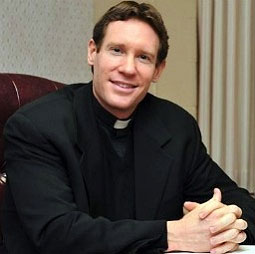 discuss the Year of Faith, “Consoling the Heart of Jesus” and his new book coming soon…”The One Thing is Three”. Â We talk about how the New Evangelization and the role model that Bl. John Paul II was to all of us. Â We all discuss “All Hearts a Fire” the new parish based program which is absolutely FANTASTIC! Â Be sure to check it out and pass it on!
discuss the Year of Faith, “Consoling the Heart of Jesus” and his new book coming soon…”The One Thing is Three”. Â We talk about how the New Evangelization and the role model that Bl. John Paul II was to all of us. Â We all discuss “All Hearts a Fire” the new parish based program which is absolutely FANTASTIC! Â Be sure to check it out and pass it on!
[powerpress]
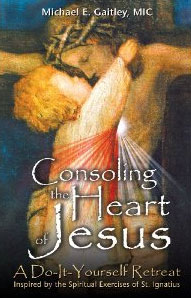 You can find the book here
You can find the book here
Michael Gaitley, MIC’s book is a form of a weekend retreat accessible to those at the beginning stages of a simple way to holiness. While reading this book, I wished I could have had it in conversing with people of little or practically no faith who yet had a longing for the faith that lies at the core of human existence. These hearts are restless until they rest in Thee, Lord and this book guides them on a journey to resting in God. –Fr. Mitch Pacwa
Tags: catholic, catholic podcast, catholic prayer, cathollc spirituality
This entry was posted on Monday, September 10th, 2012 at 9:00 am
You can follow any responses to this entry through the RSS 2.0 feed.
[powerpress] Â A few years ago, Bruce and I had the blessing of having a very special conversation with Fr. Michael Scanlan 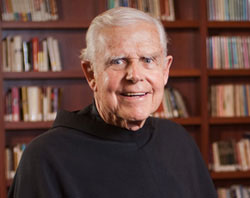 about “The Truth About Trouble: How Hard Times Can Draw You Closer To God”. Â Fr. Scanlan’s wisdom is extraordinary…he knows how to pastor us through hard times, because he has suffered it, but he also knows that it is through Jesus, with Jesus, in Jesus that in the end all will be well. Â He talks about the cancer of discontent, which is so dangerous to our spiritual lives. Â Fr. Scanlan also describes how the devil desires to use trouble to turn us away from God. Â We should realize that when that is happening and recognize, believe or not, that trouble isn’t the worst thing that could happen to us…it is actually a pathway to purification…be not afraid! Â What a gift Fr. Scanlan is to us all!
about “The Truth About Trouble: How Hard Times Can Draw You Closer To God”. Â Fr. Scanlan’s wisdom is extraordinary…he knows how to pastor us through hard times, because he has suffered it, but he also knows that it is through Jesus, with Jesus, in Jesus that in the end all will be well. Â He talks about the cancer of discontent, which is so dangerous to our spiritual lives. Â Fr. Scanlan also describes how the devil desires to use trouble to turn us away from God. Â We should realize that when that is happening and recognize, believe or not, that trouble isn’t the worst thing that could happen to us…it is actually a pathway to purification…be not afraid! Â What a gift Fr. Scanlan is to us all!
You can find it here
This entry was posted on Sunday, September 9th, 2012 at 8:24 am
You can follow any responses to this entry through the RSS 2.0 feed.
[powerpress] Msgr. Esseff reflects what it means to truly encounter Jesus. Â Do we recognize Him in the poor, the prisoner, the disabled, the stranger? Â Or do we pass Him by because we truly do not know Him? Â He offers insight primarily from the teachings found in the letter from St. James Chap 2:
My brothers and sisters, show no partiality
as you adhere to the faith in our glorious Lord Jesus Christ.
For if a man with gold rings and fine clothes
comes into your assembly,
and a poor person in shabby clothes also comes in,
and you pay attention to the one wearing the fine clothes
and say, “Sit here, please, ”
while you say to the poor one, “Stand there, ” or “Sit at my feet, ”
have you not made distinctions among yourselves
and become judges with evil designs?Listen, my beloved brothers and sisters.
Did not God choose those who are poor in the world
to be rich in faith and heirs of the kingdom
that he promised to those who love him?. Â – NAB
Msgr. John A. Esseff is a Roman Catholic priest in the Diocese of Scranton. He was ordained on May 30th 1953, by the late Bishop William J. Hafey, D.D. at St. Peter’s Cathedral in Scranton, PA. Msgr. Esseff served a retreat director and confessor to Blessed Mother Teresa.   He continues to offer direction and retreats for the sisters of the missionaries of charity around the world. Msgr. Esseff encountered St.  Padre Pio,  who would become a spiritual father to him. He has lived in areas around the world,  serving  in the Pontifical missions, a Catholic organization established by Bl. Pope John Paul II to bring the Good News to the world especially to the poor. Msgr. Esseff assisted the founders of the Institute for Priestly Formation and continues to serve as a spiritual director for the Institute. He continues to  serve as a retreat leader and director to bishops, priests and sisters and seminarians and other religious leaders around the world.  Â
To obtain a copy of Msgr. Esseff’s book byvisiting here
Be sure to visit Msgr. Esseff’s website “Building a Kingdom of  Love”
Tags: Jesus, PA, retreat, Roman Catholic
This entry was posted on Sunday, September 9th, 2012 at 7:49 am
You can follow any responses to this entry through the RSS 2.0 feed.
Episode 17 – Seeking Truth with Sharon Doran, hosted by Bruce McGregor on his KVSS Â program “The Ninth Hour”. Â Â Mary, Ark of the Covenant
[powerpress]
Sharon Doran serves as the teaching director of “Seeking Truth.†An experienced Bible Study teacher, Sharon has a passion forscripture that will motivate and challenge you to immerse yourself in God’s Word and apply His message to your every day life.
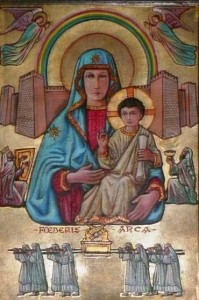 Episode 17 – Sharon and Bruce discuss Mary, the Ark of the New Covenant. Â What does this mean? Â Where do we find that in the Old and New Testament? How has that been reflected in our Sacred Tradition?
Episode 17 – Sharon and Bruce discuss Mary, the Ark of the New Covenant. Â What does this mean? Â Where do we find that in the Old and New Testament? How has that been reflected in our Sacred Tradition?
 “Seeking Truth†is an in depth Catholic Bible Study, commissioned by the Archdiocese of Omaha in response to John Paul II’s call to the New Evangelization as well as Pope Benedict XVI’s exhortation for all Catholics to study scripture. To learn more go to:www.seekingtruth.net
“Seeking Truth†is an in depth Catholic Bible Study, commissioned by the Archdiocese of Omaha in response to John Paul II’s call to the New Evangelization as well as Pope Benedict XVI’s exhortation for all Catholics to study scripture. To learn more go to:www.seekingtruth.net
Tags: ark of the covenant
This entry was posted on Saturday, September 8th, 2012 at 9:57 am
You can follow any responses to this entry through the RSS 2.0 feed.
[powerpress]Msgr. Esseff reflects on the birth of the Virgin Mary.  But even more than that, he ponder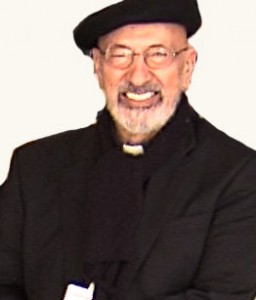 s the importance of the Blessed Mother in our lives.  The gift of her presence in the action of salvation history and  role is the “Mother” of us all.
s the importance of the Blessed Mother in our lives.  The gift of her presence in the action of salvation history and  role is the “Mother” of us all.
Be sure to visit Msgr. Esseff’s website “Building A Kingdom of Love“
Tags: blessed mother, virgin mary
This entry was posted on Saturday, September 8th, 2012 at 9:55 am
You can follow any responses to this entry through the RSS 2.0 feed.
“She will bear a son, and you shall call him Jesus“
[powerpress]
an excerpt from today’s reflection by Don Schwager:
Do you rejoice in the promises of God and trust in his saving plan for your life? There is a long venerable tradition among many Christians of celebrating the birth of Mary, the mother of Jesus our Savior, on this day. Her birth prepared for our redemption in Jesus Christ. Matthew begins his gospel with the geneology of Jesus from Abraham’s lineage through the line of David, King of Israel. Matthew concludes his geneology by stating that both Mary, Jesus’ mother and Joseph, his foster father, came from the line of David. Mary was asked to assume in faith a burden of tremendous responsibility. It had never been heard of before that a child could be born without a natural father. Mary was asked to accept this miraculous exception to the laws of nature. That required faith and trust. Second, Mary was not yet married. Pregnancy outside of wedlock was not tolerated in those days. Mary was only espoused to Joseph, and such an engagement had to last for a whole year. She was asked to assume a great risk. She could have been rejected by Joseph, by her family, by all her own people. Mary knew that Joseph and her family would not understand without revelation from God. She nonetheless believed and trusted in God’s promises. Joseph, a just and God-fearing man, believed the message given to him to take Mary as his wife and to accept the child in her womb as the promised Messiah. Like Mary, Joseph is a model of faith for us. He is a faithful witness and servant of God’s unfolding plan of redemption. Are you willing to trust and obey the Lord as Mary and Joseph did?
“Lord Jesus, you came to save us from sin and the power of death. May I always rejoice in your salvation and trust in your plan for my life”.
for the full reflection visit : Daily Reading and Meditation
Tags: don schwager, gospel of matthew
This entry was posted on Saturday, September 8th, 2012 at 1:03 am
You can follow any responses to this entry through the RSS 2.0 feed.
Vatican City, 5 September 2012 (VIS)
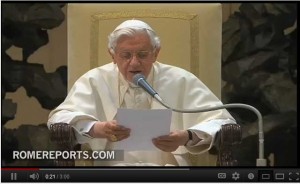
 – Benedict XVI today resumed his general audiences in the Vatican, having held them at Castelgandolfo during the month of August. Meeting with faithful in the Paul VI Hall he turned his attention to prayer in the Book of Revelation which, he explained, “presents us with the living breathing prayer of the Christian assembly, gathered together ‘on the Lord’s day'”.Revelation, Pope Benedict went on, “is a difficult book, but one of great richness. … In it a reader presents the assembly with a message entrusted by God to John the Evangelist. … From the dialogue between them a symphony of prayer arises which is then developed in many different forms up until the conclusion”.The first part of Revelation presents us with the assembly in prayer in three successive phases. The first of these highlights how “prayer is, above all, a listening to God Who speaks. Engulfed as we are by so many words we are little used to listening, and especially to adopting an interior and exterior attitude of silence so as to attend to what the Lord wishes to say to us. These verses also teach us that our prayers, often merely prayers of request, must in fact be first and foremost prayers of praise to God for His love, for the gift of Jesus Christ which brought us strength, hope and salvation. … God, Who reveals Himself as the beginning and the end of the story, welcomes and takes to heart the assembly’s request”.This first phase also includes another important element. “Constant prayer revives in us a sense of the Lord’s presence in our life and history. His presence supports us, guides us and gives us great hope. … Prayer, even that pronounced in the most extreme solitude, is never a form of isolation and it is never sterile, it is a vital lymph which nourishes an increasingly committed and coherent Christian existence”.In the second phase of the prayer of the assembly “the relationship with Jesus Christ is developed further. The Lord makes Himself visible, He speaks and acts, and the community, increasingly close to Him, listens, reacts and accepts”.In the third phase “the Church in prayer, accepting the word of the Lord, is transformed. … The assembly listens to the message, and receives a stimulus for repentance, conversion, perseverance, growth in love and guidance for the journey”.“The Revelation”, Benedict XVI concluded, “presents us with a community gathered in prayer, because it is in prayer that we gain an increasing awareness of Jesus’ presence with us and within us. The more and the better we prayer with constancy and intensity, the more we are assimilated to Him, and the more He enters into our lives to guide them and give them joy and peace. And the more we know, love and follow Jesus, the more we feel the need to dwell in prayer with Him, receiving serenity, hope and strength for our lives”.
[powerpress = Â Vatican_Radio]
Tags: book of revelation, pope benedict xvi
This entry was posted on Wednesday, September 5th, 2012 at 5:26 pm
You can follow any responses to this entry through the RSS 2.0 feed.
[powerpress]Msgr. Esseff reflects on Blessed Mother Teresa whom he met in 1984 in Beruit, Lebanon. 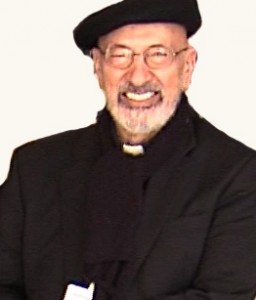 Msgr. Esseff worked alongside Blessed Mother Teresa in Calcutta, Lebanon, West Africa, Haiti and elsewhere and would go on to serve as a spiritual director and confessor for Mother Teresa and her sisters.  (The last few minutes of the reflection are particularly poignant)
Msgr. Esseff worked alongside Blessed Mother Teresa in Calcutta, Lebanon, West Africa, Haiti and elsewhere and would go on to serve as a spiritual director and confessor for Mother Teresa and her sisters.  (The last few minutes of the reflection are particularly poignant)
Be sure to visit Msgr. Esseff’s website “Building A Kingdom of Love“
Tags: blessed mother teresa of calcutta, msgr. john esseff
This entry was posted on Wednesday, September 5th, 2012 at 12:47 am
You can follow any responses to this entry through the RSS 2.0 feed.
 On this the feast day of Blessed Teresa of Calcutta:
On this the feast day of Blessed Teresa of Calcutta:
The Fruit of Prayer
The fruit of silence is prayer
the fruit of prayer is faith
the fruit of faith is love
the fruit of love is service
the fruit of service is peace.
If We Pray
If we pray, we will believe;
If we believe, we will love
If we love, we will serve.
Love to pray
Feel often during the day the need for prayer and pray.
Prayer opens the heart, till it is capable of containing God himself.
Ask and seek and your heart will be big enough to receive Him
and keep Him as Your Own.
Tags: blessed mother teresa of calcutta, missionaries of charity
This entry was posted on Wednesday, September 5th, 2012 at 12:13 am
You can follow any responses to this entry through the RSS 2.0 feed.


